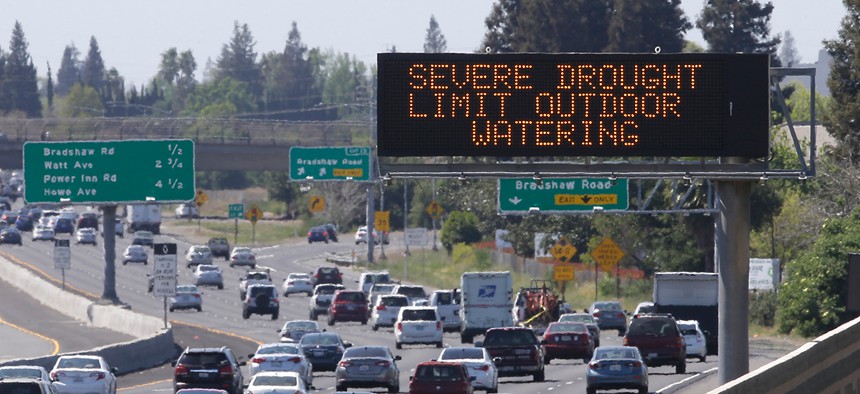California's New Water Restrictions Demand Transparency From Farmers

Motorists drive past a sign in Rancho Cordova Thursday. Rich Pedroncelli/AP
Governor Jerry Brown has finally called out how poorly the state accounts for agricultural water use.
With the state facing its lowest snowpack in recorded history—just 6 percentof the long-term average—California Governor Jerry Brown's historic mandatefor a 25 percent reduction in statewide water use has plenty of residents saying, Finally.
Since declaring a state of emergency in January 2014, Brown has called for voluntary water reductions, passed a $1 billion emergency bond package, and a historic groundwater regulation act. But these actions have not gone far enough to curtail water use, and very likely, the Governor's new restrictions are just the beginning of water-use mandates to come.
The new orders mostly focus on cities and towns, and they will be felt in every corner of urban life: from the 50 million square feet of lawns that'll be replaced with drought-tolerant landscaping, to consumer rebates for energy-efficient products, to the classic California golf courses—the bane of so many conservationists—now required to slash their water use.
Yet those even a little bit familiar with California's drought know that urban water usage accounts for only about 20 percent of the state's overall supplies. Agriculture—an economic backbone for the state that has borne tremendous losses amid the drought—uses the other 80 percent.
So what's in Governor Brown's mandate for farmers? Basically, a lot of number-crunching. Agricultural water users will be required to report in greater detail their water-use information to state regulators. Large agricultural suppliers are also changed with developing water-management plans, due in July 2016.
Data reporting probably sounds a little lax as a mandate, compared to the drastic cuts that urban areas are expected to make. Some are already disappointed. "The Governor must save our groundwater from depletion by directing the State Water Board to protect groundwater as a public resource," Adam Scow, Director of Food & Water Watch California, said in a statement.
There's no question that legislators and farmers can do more to cut back on agricultural water use intelligently, such as fostering a stronger water market and, indeed, strengthening groundwater regulation.
Yet Brown's task for farmers is an important step, because it recognizes how poorly the state manages agricultural water allocations. California has a notoriously byzantine approach, with laws dating back to the 19th century that allow water rights to the families who originally staked claims on rivers and streams. Those senior and riparian rights holders—almost entirely held by agricultural and corporate entities, according to the AP—continue to report their water use on what's basically an honor system, with information that's riddled with inaccuracy and often out of date.
Further, as a study by UC Davis Center for Watershed Sciences found, these claims use only a fraction of the water they hold the rights to—not a problem when water is abundant, but a huge problem when it's scarce. In times of drought, including this one, water allocations to junior rights holders get slashed. When senior rights holders don't report how much water they're actually using, it's screwing the smaller guys out of water that could have kept them afloat.
There's been little in the way of addressing this shamefully lax system. Brown's mandate—while it could go further—is at least a first step towards more transparency and accountability from the state's biggest guzzlers.
"We know that in order to address the drought effectively, we need much better information both on how much water we are using and at what rate," Adrienne Alvord, California and Western director at the Union of Concerned Scientists, said in a statement. "This is a critical requirement that we need to make permanent, since we know that you can't manage what you don't measure."





